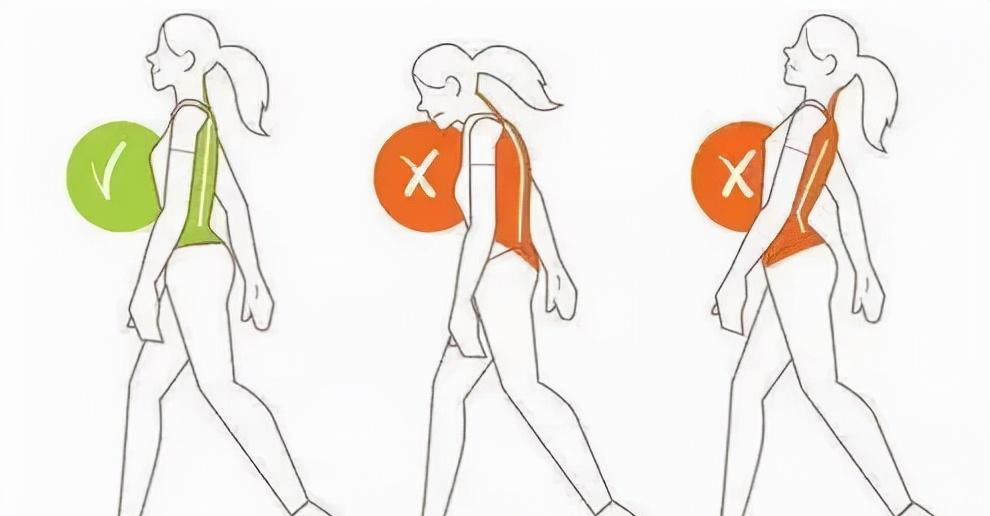Running, playing ball, climbing mountains......... In daily life, any action we do is done by relying on our legs, and the most exercise we do is walking, but these must be based on the correct way of walking, if the way of walking is not right, not only can not meet expectations, but also cause waist and leg damage!

Five of the most feared ways to walk at the waist
Hunchback type: This type of person not only bends his back, but also extends his shoulders and neck forward. Modern people often use computers, most of the time the body leans forward, the muscles of the back become stiff for a long time, the S-shape of the spine changes, in order to support the heavy head weight, the neck and waist are subjected to considerable pressure, which can easily lead to waist pain, thigh muscle pain, shoulder pain.
Anti-lumbar type: At first glance, the back spine is very straight and appears to be energetic, but a closer look will find that their waist is folded backwards, which is mostly caused by the imbalance of the abdominal muscles and back muscles, and is common in women with weak abdominal muscles. Walking in this way, the waist will produce a feeling of heaviness and fatigue.
Crab type: the legs are bent outwards when walking, and is common in men with particularly thick leg muscles and women with loose bones. This way of walking is usually related to skeletal skew, which can cause knee and hip pain over time. Such people should try to take the tiptoe forward when walking.
Left and right tilt type: everyone has their own habit of using one side of the hands and feet, so the degree of muscle development is unbalanced, which will make the pelvis tilt left and right, and the body in order to achieve balance, the whole body bones will be affected, walking to tilt left and right, a long time will lead to unilateral ankle pain, knee pain. Such people should pay special attention to not being able to hold a heavy object with one hand for a long time, or stand on one leg.
Knee bending type: more common in older people, mainly because the trunk muscles as a whole decline, showing a state of inability to support, resulting in knee bending, need to rely on the front of the thigh muscles support. As a result, the iliopsoas muscles deep in the abdomen are even weaker, and the trunk muscles are not exercised, falling into a vicious cycle of aging.
The correct posture for walking
Walk indoors: When stepping, the back foot is not deep, you can gently touch the ground with the tip of your toe, pay attention to relax the calf muscles, and after taking a step, land on the ground with the full soles of your feet. In this way, the calf muscles switch between relaxation and tension, which facilitates blood circulation. Care should be taken not to take too large a stride.
Up and down the stairs: When going up the stairs, the distance between the feet is equal to the pelvis, and the feet are lifted directly upwards; the pelvis should be able to feel the power of the pelvis to drive the body upstairs, rather than using the leg muscles; the head and feet are not the same direction, such as when the right leg is stepped, the head is biased to the left.
When descending the stairs: the distance between the feet is slightly wider than the pelvis, and the full foot is landed on the ground; the pelvis is slightly inclined with the front foot, and the strength of the back is flexibly used, and the head is tilted to the opposite side of the foot to stabilize the body.
Long distance walking: the upper body remains flexible and soft, slightly bending the elbows, feeling the shoulder blades moving back and forth, and swinging your hands to the left and right. To match the movement of the arms and shoulder blades, the pelvis will naturally move forward, rhythmically moving the legs, and it is not easy to feel tired.
Carrying heavy luggage: The key is to reduce the scope of gravity, try to keep the luggage close to the body, the distance between the feet is equal to the pelvis, and step forward, so as to ensure physical stability. If the arm and shoulder swing are small, the luggage will not be "thrown around", reducing unnecessary load.
Tips
The World Health Organization has rated walking as "the best exercise in the world", and walking more than 3 hours a week can reduce the risk of cardiovascular disease by 35%-40%; over 60 years old, walking for more than 45 minutes three days a week can prevent Alzheimer's disease; walking for more than 7 hours a week can reduce the breast cancer incidence rate by 20%. Therefore, it is recommended that adults perform more than 6,000 steps of physical activity per day. Walk 6,000 steps a day≈ 3 to 4 kilometers≈ about 30 minutes. Very good for good health.